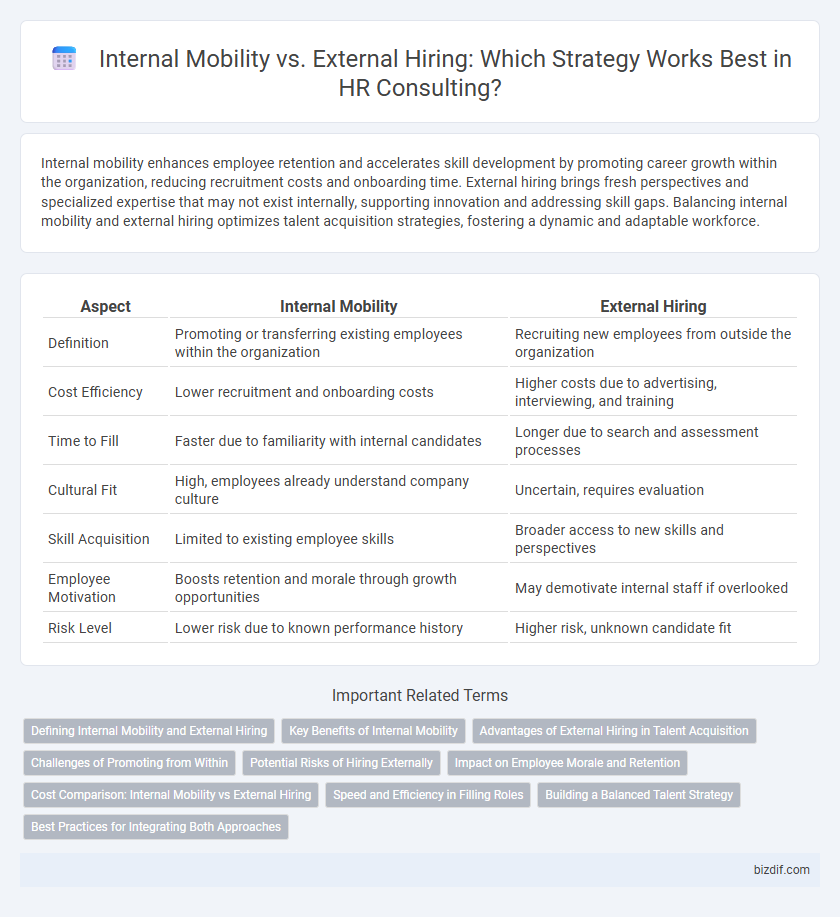Internal mobility enhances employee retention and accelerates skill development by promoting career growth within the organization, reducing recruitment costs and onboarding time. External hiring brings fresh perspectives and specialized expertise that may not exist internally, supporting innovation and addressing skill gaps. Balancing internal mobility and external hiring optimizes talent acquisition strategies, fostering a dynamic and adaptable workforce.
Table of Comparison
| Aspect | Internal Mobility | External Hiring |
|---|---|---|
| Definition | Promoting or transferring existing employees within the organization | Recruiting new employees from outside the organization |
| Cost Efficiency | Lower recruitment and onboarding costs | Higher costs due to advertising, interviewing, and training |
| Time to Fill | Faster due to familiarity with internal candidates | Longer due to search and assessment processes |
| Cultural Fit | High, employees already understand company culture | Uncertain, requires evaluation |
| Skill Acquisition | Limited to existing employee skills | Broader access to new skills and perspectives |
| Employee Motivation | Boosts retention and morale through growth opportunities | May demotivate internal staff if overlooked |
| Risk Level | Lower risk due to known performance history | Higher risk, unknown candidate fit |
Defining Internal Mobility and External Hiring
Internal mobility refers to the strategic process of promoting or transferring existing employees within an organization to new roles or responsibilities, leveraging their current skills and company knowledge. External hiring involves recruiting candidates from outside the organization to fill vacant positions, bringing in fresh talent and diverse perspectives. Both approaches impact workforce planning, talent development, and overall organizational agility in HR consulting practices.
Key Benefits of Internal Mobility
Internal mobility enhances employee retention by leveraging existing talent, reducing recruitment costs by up to 50%, and accelerating onboarding through familiarization with company culture. Employees engaging in internal mobility often exhibit higher job satisfaction and productivity, contributing to a 20% increase in overall performance metrics. Organizations benefit from improved knowledge continuity and stronger leadership pipelines by prioritizing internal promotions and lateral moves.
Advantages of External Hiring in Talent Acquisition
External hiring introduces fresh perspectives and diverse skill sets that can drive innovation and fill capability gaps within the organization. It expands the talent pool, enabling access to specialized expertise and industry best practices not available internally. This approach enhances competitive advantage by bringing in candidates with varied experiences who can challenge existing processes and contribute to organizational growth.
Challenges of Promoting from Within
Promoting from within faces challenges such as skill gaps that may limit employees' readiness for advanced roles, requiring targeted training and development programs. Internal mobility can also lead to potential bias or favoritism perceptions, impacting team morale and organizational fairness. Additionally, limited internal candidates may slow down urgent hiring needs, necessitating strategic workforce planning to balance internal promotions with external recruitment.
Potential Risks of Hiring Externally
Hiring externally poses potential risks such as cultural misfit, longer onboarding times, and increased recruitment costs that can impact overall organizational performance. External candidates may require extensive training to align with company values and processes, leading to productivity delays. Furthermore, external hires could face integration challenges, affecting team cohesion and employee morale.
Impact on Employee Morale and Retention
Internal mobility enhances employee morale by demonstrating commitment to career growth and recognizing existing talent, which strengthens loyalty and reduces turnover. In contrast, external hiring can sometimes cause dissatisfaction among current employees who may feel overlooked or undervalued, potentially harming retention rates. Prioritizing internal advancement fosters a positive workplace culture that encourages long-term engagement and stability.
Cost Comparison: Internal Mobility vs External Hiring
Internal mobility significantly reduces recruitment expenses by minimizing advertising costs, agency fees, and onboarding time compared to external hiring, which often incurs higher sourcing and training expenditures. Promoting existing employees leverages institutional knowledge and accelerates productivity, resulting in lower overall talent acquisition costs. External hiring may bring fresh skills but typically demands greater investment in salary negotiations, background checks, and cultural assimilation, increasing the total cost per hire.
Speed and Efficiency in Filling Roles
Internal mobility accelerates the hiring process by leveraging existing employee knowledge and reducing onboarding time, resulting in quicker role fulfillment. External hiring often involves lengthier recruitment cycles, including sourcing, screening, and cultural fit assessments, which can delay critical role placements. Prioritizing internal talent pools enhances efficiency and minimizes downtime, driving improved organizational agility.
Building a Balanced Talent Strategy
Building a balanced talent strategy requires evaluating internal mobility and external hiring to optimize workforce capabilities. Internal mobility leverages existing employee skills, promotes engagement, and reduces recruitment costs, while external hiring introduces fresh perspectives and specialized expertise. Combining both approaches strategically enhances organizational agility, talent diversity, and long-term business performance.
Best Practices for Integrating Both Approaches
Balancing internal mobility and external hiring enhances workforce agility and talent retention by leveraging existing employee skills while infusing fresh perspectives. Best practices include creating transparent career development pathways, implementing data-driven talent analytics to identify skill gaps, and fostering a culture that values both internal advancement and strategic external recruitment. Integrating these approaches through cross-functional collaboration ensures alignment with organizational goals and maximizes overall talent optimization.
Internal mobility vs external hiring Infographic

 bizdif.com
bizdif.com